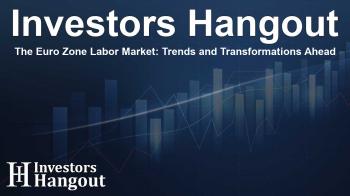The Euro Zone Labor Market: Trends and Transformations Ahead

The Euro Zone Labor Market: What Lies Ahead?
The European Central Bank (ECB) has recently conducted a thorough examination of the euro zone labor market, revealing a notable shift in its dynamics. Despite a period of exceptional resilience, several factors may indicate that this strength is poised for a change. However, the prospects do not imply an immediate dramatic decline, as the findings illustrate a complex and evolving landscape.
Current Labor Market Condition
As it stands, the unemployment rate in the euro zone has reached a record low of 6.3%. This unexpected outcome has raised eyebrows since the economy has faced stagnation over the previous year. It poses a curious challenge to economic norms, where typically, a lagging economy correlates with a weakening labor market.
Employment Growth Surpassing GDP
Traditionally, employment growth in the euro area aligns closely with real GDP growth. However, since 2022, employment has outpaced GDP growth, suggesting unique circumstances at play. The ECB highlights that rising profit margins have allowed companies to retain employees for extended periods, despite facing declines in revenue.
Factors Influencing Labor Market Stability
Real wages have begun to rise, slowly aligning with historical trends, while stabilization in energy prices has alleviated pressure on production costs. This stabilization is critical in bridging the gap between the levels of output and employment, indicating a potential realignment in labor market dynamics.
Labor Hoarding and Its Effects
Labor hoarding, a strategy utilized by companies to retain employees during uncertain economic phases, peaked in the third quarter of 2022. The ECB's findings suggest that the motivation or capability to sustain this level of labor retention is gradually diminishing, which could influence future employment rates. The ECB anticipates that the labor market will start gravitating closer to historical correlations with economic output.
The Future of the Euro Zone Labor Market
Despite ongoing changes, significant declines in the labor market are not anticipated. Some policymakers have expressed concerns about a swift deterioration in the labor market, which could impact disposable incomes, demand levels, and inflation. However, the results from the ECB's study do not substantiate these fears.
Expectations for Unemployment Rates
According to the ECB, the unemployment rate is expected to maintain its low levels in the upcoming quarters. Overall, the survey data point towards a relatively stable trajectory for the labor market, suggesting that while some adjustments may occur, the immediate future remains secure.
Conclusion: A Complex Landscape Ahead
The euro zone labor market currently illustrates a complex interplay between resilience and impending changes. As the ECB's analysis sheds light on the factors influencing this environment, stakeholders must remain vigilant and responsive to the evolving trends. Understanding the underlying dynamics will be essential in navigating the challenges and opportunities that lie ahead.
Frequently Asked Questions
What is the current unemployment rate in the euro zone?
The unemployment rate in the euro zone is currently at a record low of 6.3%.
Is the euro zone labor market expected to weaken dramatically?
No, the ECB does not predict a dramatic weakening of the labor market in the near future.
What factors are influencing employment growth in the euro zone?
Rising profit margins and the stabilizing energy costs have played a significant role in influencing employment growth.
What does labor hoarding mean in this context?
Labor hoarding refers to the practice of companies retaining workers during economic downturns, which peaked in the euro zone's labor market as of late 2022.
Are real wages rising in the euro zone?
Yes, real wages are currently rising and are starting to align with historical trends.
About The Author
Contact Dominic Sanders privately here. Or send an email with ATTN: Dominic Sanders as the subject to contact@investorshangout.com.
About Investors Hangout
Investors Hangout is a leading online stock forum for financial discussion and learning, offering a wide range of free tools and resources. It draws in traders of all levels, who exchange market knowledge, investigate trading tactics, and keep an eye on industry developments in real time. Featuring financial articles, stock message boards, quotes, charts, company profiles, and live news updates. Through cooperative learning and a wealth of informational resources, it helps users from novices creating their first portfolios to experts honing their techniques. Join Investors Hangout today: https://investorshangout.com/
The content of this article is based on factual, publicly available information and does not represent legal, financial, or investment advice. Investors Hangout does not offer financial advice, and the author is not a licensed financial advisor. Consult a qualified advisor before making any financial or investment decisions based on this article. This article should not be considered advice to purchase, sell, or hold any securities or other investments. If any of the material provided here is inaccurate, please contact us for corrections.

